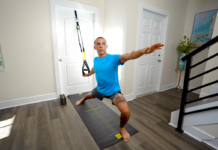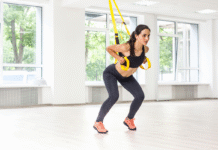Blossoming flowers, pollen-soaked porches, and those buzzing bees we all secretly panic at seeing.
There is such beauty in nature fully blossoming — waking up from the cold, dead winter. Summer also brings some great outdoor weather!
As we are increasing our activity and getting out, there is an important component of exercise training we need to address.
In past articles, we discussed two somewhat well-known aspects of fitness: cardiorespiratory training and resistance training. However, there is a commonly forgotten third aspect to take into account when navigating your health—flexibility training. It is a must for people of all ages (Except babies, they’ve got it going on!).
The American College of Sports Medicine (ACSM) defines flexibility as, “the ability to move through a joint’s ROM (range of motion).” You may be thinking that no one ever said anything about flexibility to you at the gym.
People are also reading…
Stretching is specifically what I mean when I say flexibility training. I can hear your sighs, but you know I am right.
Stretching is good for you. It can help reduce joint pain, protect against injury, allow your body to move at its full potential and help with daily activities. Harvard Health released an article about stretching that states, “Without it, the muscles shorten and become tight. Then, when you call on the muscles for activity, they are weak and unable to extend all the way.”
Have you ever found a really old rubber band? When you try stretching it out — SNAP! It breaks. Now imagine trying to use a muscle that hasn’t been stretched. Stretching matters. There are several different types of stretching, but today we are going to focus our attention on static stretching.
Static stretching is defined by ACSM as, “slowly stretching a muscle/tendon group and holding the position for a period of time (i.e., 10-30 seconds). Static stretches can be active or passive.”
Before we go any further, there is a very important rule with stretching — you must warm up. This is not a suggestion. This is a requirement. You cannot and should not stretch a cold muscle.
Some different things you can do to warm up: walking, dancing, jumping rope, jumping jacks, arm circles, riding a stationary bike, or using an elliptical machine. Warm up those muscles for 5 to 10 minutes before beginning your stretching routine.
After you have completed the warm-up, you can begin stretching.
ACSM states, “Active static stretching involves holding the stretched position using the strength of the agonist muscle as is common in many forms of yoga.” An example of active static stretching would be leaning your head to one side to stretch the muscles in your neck.
Passive static stretching is defined by ACSM as “assuming a position while holding a limb or other part of the body with or without the assistance of a partner or device (such as elastic bands or a ballet barre).”
An example of passive static stretching would be lying flat on the floor, attaching a belt or strap around your foot with the other end in your hand, and bringing your leg straight up with your knee straight until you feel a stretch in the back portion of your upper leg (also known as a hamstring stretch).
Now, let’s discuss how to stretch. This is an important aspect of your stretching program.
When performing a stretch, the goal is to not go into the position and feel unbearable pain. You are taking the muscle too far before it’s ready if stretching is painful.
The goal when you do a specific stretch is to go until you feel tension or a pulling sensation in that muscle.
Go back to our hamstring stretch example in the last paragraph. If you get your leg up to form a 90-degree angle and you think you are going to need a hospital, you’ve gone too far. Try lowering your leg back toward the floor until you feel a slight pull in the back part of your leg. Remember, rule number one is to warm up before you stretch. Rule number two is to stretch to the point of tension, not agony. Now, how do we make stretching a part of our routine?
ACSM recommends performing a stretching routine at least 2 to 3 days per week with daily stretching being the most effective.
Hold the stretch for 10 to 60 seconds and stretch each of the major muscle-tendon units. ACSM stated, “In older adults, stretching for 30-60 seconds may result in greater flexibility gains than shorter duration stretches.” It would be best to perform your stretches after you complete your workout for the day, when your muscles are nice and warmed up.
Another great way to get into a stretching routine is to involve the entire family. Eat dinner together, go for a short walk or have a mini dance party, and complete a beginner stretching video online.
YouTube is filled with videos for you to help jump-start a stretching routine. Please be sure you choose an appropriate video for your experience level. If you are new to stretching, do not try an intermediate or advanced stretching video. We want this to benefit and not hurt you. Work your way to intermediate videos and stretching routines.
You can also consider where you feel tight or stiff and start the habit of stretching those areas. As you see improvement in those problem areas, move on to other areas or focus on keeping every muscle happy and healthy.
Motion is lotion! We are not made to sit still and stiffen up. If you are worried about balance issues or protecting your joints, try searching for seated stretching routines. Many stretches can be performed while in a seated position.
If you have any questions, send me an email at [email protected]. And be sure to check out YouTube for some free stretching routines to add to your tool belt of health.
Kayla Thompson is a diabetes care coordinator at the HopeHealth Medical Plaza in Florence and is a certified exercise physiologist through the American College of Sports Medicine. She has a master of science degree in clinical exercise science.













